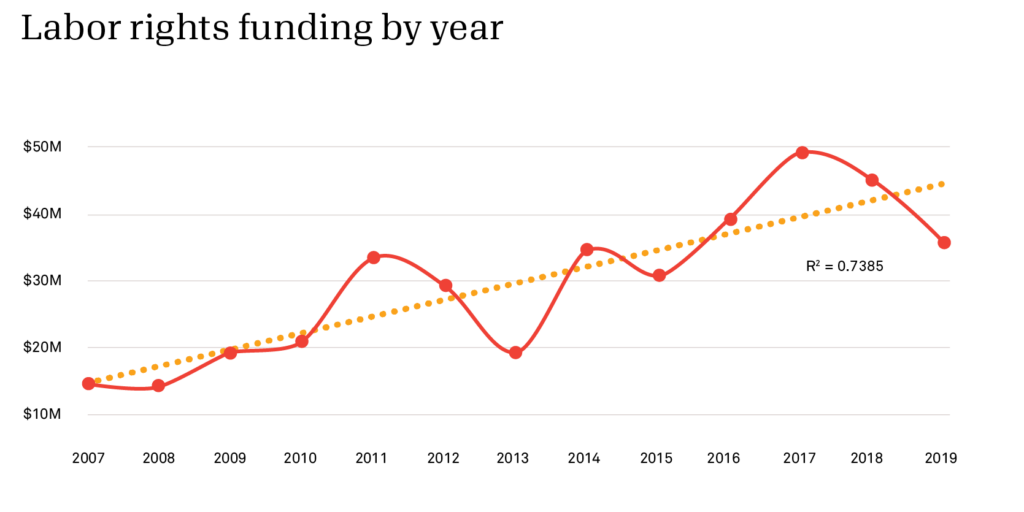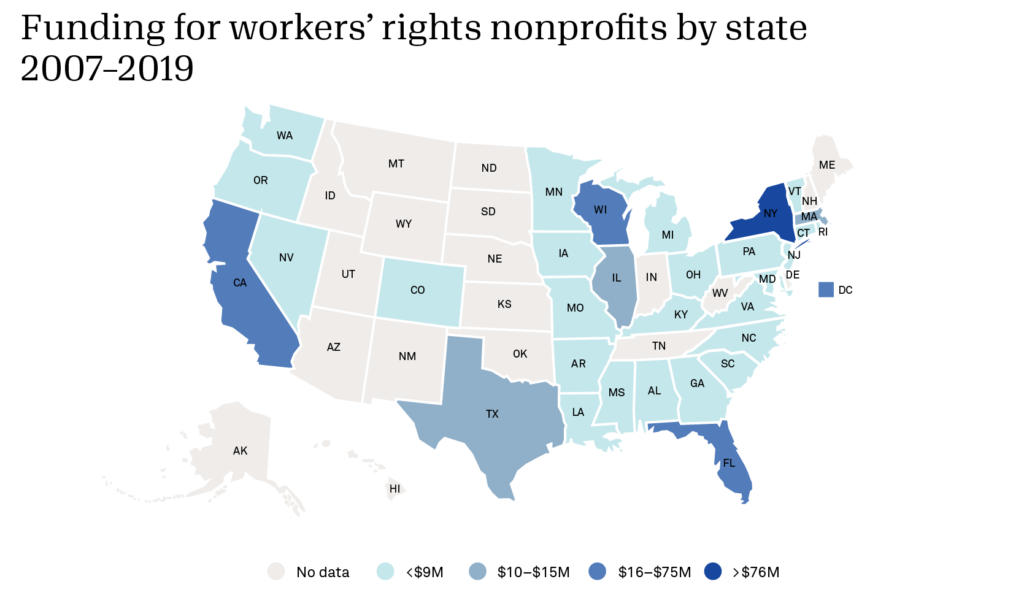Alt-labor: What are workers’ rights nonprofits?

As the New Year promises to bring many changes to the social sector and beyond, one thing remains unchanged and top of mind for many: the economic climate in the U.S. With high levels of inflation persisting and the possibility of a recession looming, many are predicting what 2023’s economy will mean for today’s workforce.
Unfortunately, there’s no crystal ball that can tell employees what to expect this year. However, we can revisit the topic of workers’ rights through a new lens by exploring the increasing role that a newer breed of labor organizations plays in the social sector.
Read this blog to learn more about how these nonprofits are addressing the issues facing workers today by filling gaps left by traditional labor unions, and find out what Candid’s data says about philanthropic support for this growing movement.
The rise of “alt-labor” nonprofit organizations
The United States’ workforce has seen momentous changes over the last four decades. Take the manufacturing industry, for example. As this sector declined in the U.S., its labor force shrank, and its once powerful unions withered. Simultaneously, there has been an increase in the number of lower paying and harder-to-organize jobs in the service sector.
The unique and dynamic needs of such workers have given rise to a new form of labor organizations. Meet the growing “alt-labor” movement: today’s emerging ecosystem comprised of the latest variety of workers’ rights organizations. Unlike 501(c)(5) labor unions, most alt-labor organizations are 501(c)(3) nonprofits. Thus, they cannot engage in collective bargaining on behalf of workers or formally organize legal strikes. Instead, they pursue a variety of other strategies centering on litigation, education, and industry-wide advocacy.
For example, the National Domestic Workers Alliance (NDWA) undertook a six-year lobbying campaign in New York to pass better protections for domestic workers. Similarly, the Restaurant Opportunities Center (ROC) has pursued a legal strategy of suing restaurant owners for wage violations and used the legal settlement process as an opportunity to negotiate additional rights for workers.
Foundation funding for workers’ rightsi
Unlike labor unions, alt-labor nonprofits are not financially sustained from membership dues. Instead, they rely on the same kinds of funding streams as traditional community-based nonprofits: individual donations, volunteers, and support from institutional philanthropy.
Funding to workers’ rights organizations increased since the 2008 financial crisis.
According to Candid data, funding from large foundations to workers’ rights nonprofits more than doubled between 2007 and 2019, from $14.5 million to $35.6 million. This isn’t surprising when you consider the recent historical trends in funding for these organizations, which have increased continuously—with a notable dip in 2013 and a peak of $49 million in 2017.

New York is the epicenterii of funding for workers’ rights nonprofits.
New York-based organizations represented 20% of all workers’ rights nonprofits and received 35% of all funding dollars, totaling $132.6 million. This figure accounts for more than the entire sum of funding for California, Texas, and Florida combined. Within New York state, alt-labor organizations based in New York City received the vast majority of funding.
In fact, organizations based in New York County (Manhattan) received $127 million in funding. In comparison, organizations in the District of Columbia and Wisconsin, which secured the second and third most funding, only received $75 million and $35 million respectively.

The Ford Foundation was by far the biggest funder of workers’ rights nonprofits.
The Ford Foundation provided $92 million—about 25 percent—of all funding to workers’ rights nonprofits from 2007 to 2019. Next in line were the W.K. Kellogg and Novo Foundations, whose funding totaled $32 million and $29 million respectively. Both the Kellogg and Ford Foundations are part of the Labor Innovations for the 21st Century (LIFT) Fund, an institution that fosters relationships between the traditional and alt-labor movements.
Candid data also revealed that the top funders for workers’ rights organizations were independent foundations.
Top 10 foundations to workers’ rights nonprofits, 2007-2019
| Foundation | Location | Funding granted between 2007-2019 | Percentage of total funding | |
|---|---|---|---|---|
| 1 | Ford Foundation | NY | $92,351,834 | 24.0% |
| 2 | W.K. Kellogg Foundation | MI | $31,651,278 | 8.2% |
| 3 | NoVo Foundation | NY | $29,078,500 | 7.6% |
| 4 | Public Welfare Foundation, Inc. | DC | $17,678,500 | 4.6% |
| 5 | Marguerite Casey Foundation | WA | $17,527,500 | 4.6% |
| 6 | Bill & Melinda Gates Foundation | WA | $12,453,791 | 3.2% |
| 7 | Foundation to Promote Open Society | NY | $12,079,216 | 3.1% |
| 8 | The James Irvine Foundation | CA | $11,935,000 | 3.1% |
| 9 | The California Endowment | CA | $10,226,937 | 2.7% |
| 10 | The Lynde and Harry Bradley Foundation, Inc. | WI | $9,500,000 | 2.5% |
Alt-labor and the future of workers’ rights
While alt-labor nonprofits have secured an ever-growing presence in the workers’ rights movement, it’s too early to say if support for these workers’ rights organizations will continue to expand. The pandemic highlighted the importance of essential workers, and public support for unions reached an all-time high since the 1960s.
But for now, our Magic 8 Ball™ responds with, “Ask again later,” to the question of whether the alt-labor movement will continue to build on its early momentum and further influence the future of labor organizing and advocacy. In the meantime, Candid will continue to collect data and track the role workers’ rights organizations play in the social sector and the economy at large.
iTo identify workers’ rights organizations, we first examined a list of all U.S. nonprofits in Candid’s database coded for labor rights (SR020500), labor studies (SG090600), and organized labor (SN020306), according to the Philanthropy Classification System. We then reviewed the largest 1,000 organizations by revenue size and verified them for accuracy for this analysis. Next, using the Foundation 1000, we identified all grants to organizations in the cleaned list between 2007 and 2019, the latest year for which data is available. The Foundation 1000 is Candid’s research set containing 1,000 of the largest U.S. private and community foundations each year and their grants of $10,000 and more.
iiThis state-level analysis is based on organizations’ addresses according to Candid’s database. It is, thus, possible that funding went towards activities outside the geographical locales of the organizations’ headquarters.







Charley Morrow says:
This is a wonderful post. It would be great to hear a post-COVID pudate